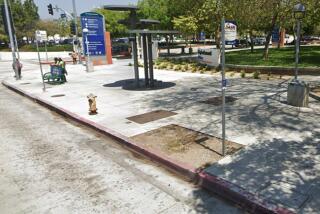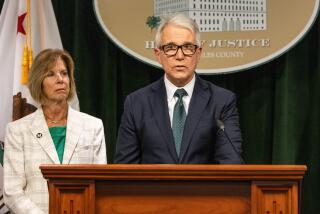Attack at 75 MPH Was a Driver’s Worst Nightmare
SAN JOAQUIN, Calif. — It was a bus driver’s impossible choice.
His backside was facing scores of passengers--none of whom passed through security screening--and his eyes were fixed on the long, dark road ahead.
Suddenly, traveling 75 mph, he felt a sharp blade at his throat. If his impulse was to let go of the steering wheel and fight, bus driver Abel Hernandez almost certainly knew it would mean crashing the bus and killing passengers.
That was the predicament Monday night on a stretch of Interstate 5 that cleaves the cotton fields of the San Joaquin Valley--moments before an accident that killed two people, injured more than two dozen others and left three hospitalized Tuesday in fair condition.
The carnage and the obvious vulnerability of thousands of drivers to such attacks were enough to prompt federal Transportation Security Administration officials to pledge Tuesday to speed up plans for improved safeguards on buses and trains nationwide.
A Greyhound spokesman said the Monday night accident might have been prevented if the government had done more to help improve bus security.
Until moments before the attack, all appeared normal on Greyhound Bus No. 7418, tooling along the flat agricultural expanse of Fresno County, halfway on its trip from Los Angeles to San Francisco. Forty-five passengers from as far as Brazil and Israel were aboard, half of them dozing and half finishing fast food from a pit stop 35 miles down the road.
Shortly after 8:30 p.m., a passenger described by authorities as a deranged drifter from Los Angeles who had made repeated visits to the bathroom bounded to the front of the bus.
No one apparently saw that 27-year-old Arturo Tapia Martinez was clutching a pair of scissors. The next thing passengers heard was bus driver Hernandez, 50, of Pomona, shouting “Hey! Hey! Hey!” as he tried to fight off Martinez and still maneuver the 36,000-pound vehicle.
The struggle didn’t last long, authorities said, just long enough for Hernandez to have his throat slit and his bus roar off the freeway and flip over on its side into a cotton field.
Two unidentified adult female passengers died at the side of the road near Coalinga. Helicopters transported the more seriously injured to hospitals. Two dozen passengers were treated for minor injuries and released. Three others, including Hernandez, remain hospitalized Tuesday in fair condition.
Martinez, a Mexican national who carried no identification, tried to escape, but passengers pointed him out to authorities and he was caught a short distance away. Late Tuesday, he remained in Fresno County Jail under a suicide watch.
Authorities say he told them numerous stories about why he did it, but none of them makes much sense. They are looking into the possible role of drugs, alcohol or mental illness.
“There doesn’t seem to be a motive,” Sgt. Jay Stuart said. “It’s likely he was just a goofball.”
Alfredo Saravia, who was heading to Oakland to visit his sister, told reporters that he was falling asleep when the attack broke out. “The people in front ... tried to stop the guy but he already had the driver. Everything happened in seconds. The bus started tumbling and went off the road and started flipping.”
One female passenger, who spoke on condition of anonymity because she was cutting university classes, said it was her post-Sept. 11 fears that caused her to take the bus instead of fly.
“A couple went through the windshield. Somehow I ended up on my feet, standing one foot on the window and one on an overhead rack,” she said. “People were falling onto people. You had to walk over people to get out.”
The west side of Fresno County, a swath of cotton and vegetable land that extends mile upon mile with scarcely a tree, is one of the loneliest stretches of California. The last time authorities can recall anything noteworthy happening there was a few years back when actress Anne Heche was found wandering nearly naked in a cotton field, muttering that she was catching a spaceship to heaven.
About 20 passengers who walked away without injuries were taken to a community center in the tiny farm town of San Joaquin and interviewed by sheriff’s investigators until 3 a.m.
One young woman with purple hair and nose rings hugged and kissed her boyfriend, who had driven 200 miles from Santa Rosa to pick her up. The others, dog tired, boarded two Greyhound buses in the chilly early morning air. They were headed to the Bay Area, to the places where they were supposed to arrive five hours earlier.
The replacement Greyhound driver, who did not give his name, said the attack was a bus driver’s worst dream come true.
“You think about it all the time,” he said. “There’s nothing protecting your back.”
In the last year, Greyhound has hired more security guards and added cameras to its 111 terminals. The guards use hand-held metal detectors to scan about one in five randomly chosen buses at 30 locations nationwide, including Los Angeles.
The San Francisco-bound bus was not selected for security screening, said Lynn Brown, a spokeswoman for Greyhound.
Among the security improvements the industry is lobbying for are increased weapons screening of passengers, improved emergency communications systems for buses and better protection for drivers. “No decisions have been made,” said David Steigman of the Transportation Security Administration.
Federal funding for surface transportation security is $15 million--a tiny proportion of the more than $6 billion being spent mainly on aviation.
“Had we the funding to improve our security ... perhaps this incident could have been prevented,” said Brown, the Greyhound spokeswoman.
Despite increased security spending by the company--including the distribution of cellular phones programmed for 911 calls--the driver’s seats still have no shield, and drivers are as vulnerable as ever as they ferry 25 million passengers a year.
“There isn’t a bus manufactured in the U.S. with an enclosed area for the driver,” said Jamille Bradfield, another representative for Greyhound. “Incidents like this are extremely rare. Bus travels remains the safest mode of transportation from city to city.”
More to Read
Sign up for Essential California
The most important California stories and recommendations in your inbox every morning.
You may occasionally receive promotional content from the Los Angeles Times.










